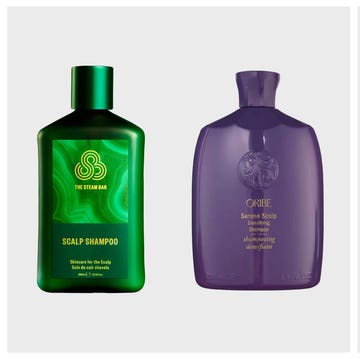We earn a commission for products purchased through some links in this article.
How to get thicker hair, according to the experts
From clinic-grade products and innovative ingredients to expert advice and styling techniques, this is your definitive guide to fuller locks

‘How to get thicker hair’ is one of the most-searched beauty questions on Google, and who can blame us? From tackling hair loss and thinning to getting the biggest, bounciest blow dry, we strive for thicker hair because, quite simply, it looks and feels healthier.
But how exactly do you get thicker hair? Can social-media claims about rosemary oil and other hair-growth ingredients be believed? And is there a simple routine for achieving enviable lengths? Here, we ask the experts and suggest a hair-thickening regime based on tried-and-tested recommendations.
Meet the experts
Hannah Gaboardi leading trichologist
Dr Margo Gkini in-house dermatologist at Hair + Me
Mark Leeson award-winning hairstylist
Anabel Kingsley consultant trichologist and brand president at Philip Kingsley
Gustav Fouche leading hairstylist and hair health expert
Scott Ade senior hairstylist at Larry King Salons
What does hair 'thickness' refer to?
Biologically, hair thickness refers to the diameter of individual hair strands, giving rise to your hair type – aka fine, medium or coarse. Fine hair has the smallest diameter and is often the most delicate. However, how thick our hair looks isn’t just about strand size – it’s also about hair density; that is, the number of hairs per square centimetre on your scalp or, more simply, the total number of strands you have. “People can have fine hair but a lot of density, making their hair appear full (but breakage prone), whereas someone can have thicker strands but less density, so hair loss is more obvious,” explains the leading trichologist Hannah Gaboardi. When we talk about wanting ‘thicker hair’, therefore, we are actually referring to several aspects of hair quality.
What influences hair thickness?
Hair thickness and hair density are primarily genetic. However, they can also be affected by:
Hormonal factors: “Menopause is one of the biggest causes of hair thinning in women,” explains Gaboardi. “Lower oestrogen shortens the hair-growth cycle, while higher relative levels of androgens (like DHT) can shrink hair follicles, leading to thinning.”
Poor nutrition: “Hair is the second-fastest growing cell your body makes, so its nutritional requirements are very high,” explains the consultant trichologist Anabel Kingsley. “Nutritional deficiencies, particularly in iron, vitamin D, zinc and protein, can contribute to hair thinning,” continues the dermatologist Dr Margo Gkini.
Stress and lifestyle: “Chronic stress increases cortisol levels, disrupting the hair-growth cycle and causing excessive shedding,” warns Dr Gkini. Styling and chemical treatments also lead to breakage, while inflammatory scalp conditions such as seborrheic dermatitis may contribute to hair loss.
Can you change hair thickness?
Your genetic hair type is set, and you can’t magically increase the number of hair follicles you have either. But, with the right routine and products (our picks below), you can improve hair quality, protect and stimulate your follicles, and prevent further thinning. That, alongside volume-based styling techniques, will lead to healthier and denser-looking locks.
Here is your expert-backed guide to achieving thicker hair:
1/ Boost scalp health
One big mistake people make when seeking thicker hair is solely focusing on their strands. “Scalp health is everything," says the hairstylist Mark Leeson. "You wouldn’t expect plants to grow in unhealthy soil – and your scalp and hair is no different.” In fact, a flaky, imbalanced scalp can cause hair loss by damaging hair as it emerges from the follicle. Regular cleansing, exfoliating (with sugar scrubs, retinol and AHAs) and gentle massage can help remove scalp build-up and improve blood flow, preventing clogged follicles. Hydrating the scalp to prevent dryness and irritation is also important because it actually has a weaker barrier than the skin on our faces.
2/ Try the hair loss hero
If you are really struggling with hair loss and thinning – i.e. you can see your scalp through the sparse strands – your first port of call should be your doctor to rule out any underlying health conditions. Then, the hero of your at-home routine is likely to be Minoxidil – one of the most effective treatments for hair loss. “Research shows that it helps to shorten the shedding (telogen) phase of the hair cycle and lengthens the actively growing (anagen) phase, with results in four to six months,” explains Kingsley. “In some cases, Minoxidil may also promote growth from previously dormant follicles.”
3/ Go beyond biotin and rosemary oil
Curious about whether biotin and rosemary oil – two social media-based hacks for hair growth – are worth trying for thicker hair? You probably don’t need them. According to the hair health expert Gustav Fouche (and countless other experts), “biotin is only beneficial for hair when you have a deficiency – and that’s pretty uncommon”. Despite its popularity in supplements, most people get sufficient biotin from their diet. As for rosemary oil, while creating quite the social media storm, experts – including Gaboardi – suggest it can “block follicles and actually compromise growth by causing excessive oil build up”. Instead look to hair-growth serums powered by “peptides and growth factors, which help strengthen the hair shaft and maintain healthy follicle function,” says Dr Gkini. “Caffeine also stimulates hair follicles, increases scalp microcirculation and prolongs the anagen phase, encouraging fuller hair,” continues Fouche. Keep an eye out for antioxidant-rich and botanical ingredients like pumpkin seed extract or natural plant oils, and scalp-nourishers such as niacinamide and aloe vera, too.
4/ Choose nourishing shampoos
While you might instinctively reach for any shampoo marketed for ‘hair loss’ or ‘volumising’, remember that wash-off products “won’t treat the root cause of thinning because the actives aren’t left on the scalp for long enough,” reveals Kingsley. Equally, “a common mistake is relying on products labelled 'thickening', which actually get their results through silicone,” says Fouche. “Silicone can dehydrate hair, eventually making it finer, weaker and more breakage-prone.” What your hair needs more is moisture and protection, with any plumping effect from your shampoo a welcome bonus. This is especially important for curly hair because moisture keeps curls looking fuller. Coarse hair, stripped of its natural moisture, also shows reduced volume.
5/ Boost volume
Anyone with fine hair knows the struggle of trying to add body, but “one big misconception is that using more product means more volume,” says Leeson. “In reality, if you overload fine hair, you’ll actually lose lift.” Equally, too much spray can overcoat your strands, leading them to separate out and look wispy. To avoid this, “use a lightweight mousse to plump up hair without weighing it down, and a dry volume spray into the roots whilst they are lifted up,” advises the hairstylist Scott Ade. “I’d recommend styling with the dryer on a slower setting and taking large sections to give the hair togetherness, too.” Ade is also the brains behind the iconic ‘Thickening Haircut’, so a reminder that regular trims will stop split ends making your tresses appear even finer.
Below, our pick of the best at-home products for thicker hair


Kiss Curls were the biggest hair trend at the Met

The best hair extension specialists in London

Kendall Jenner got a '70s-style bouncy blow-out

How to get Hailee Steinfeld's 'clavi-cut' bob
















